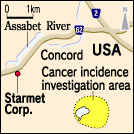| High cancer rate in daughter's generation The limits of a personal survey |
| *The interviewee in this story prefers to remain anonymous to avoid possible repercussions from other Concord residents more concerned with property values than a safe environment. Her name, her daughter's name and the street name have been changed. |
Turning off a road running through a dusky
forest, I drove up the driveway to my destination,
the home of Louise O'Brian.
O'Brian met me at the front door. "You
came all the way from Hiroshima?" Studying
my business card, she sat down at her chandelier-lit
dining room table.
"Actually, for some years I haven't
talked to anyone about my survey--and I've
never spoken to a journalist about it. As
an amateur, no matter what I studied, I couldn't
prove any causal relationship between Starmet
Corporation and my daughter's death."
![]() A painstaking, street-by-street record
A painstaking, street-by-street record
"This is what I found out about cancer
patients in the area." She spread three
large charts on the table. They were titled
"Incidence of Cancer - Lived in Concord 10 Years or More."
For each street, O'Brian had carefully entered
the following information: type of cancer,
year of onset, age of onset, and whether
or not the patient had died.
O'Brian lives near the south-central tip
of Concord, Massachusetts, about three kilometers
(less than two miles) downwind of Starmet
Corporation (the former Nuclear Metals Co.),
which is on the southwest tip. "Our
family moved here in 1966. Our oldest daughter
was four and Jeannine, who died of cancer,
was three. Our son was born in Concord that
year."
The houses in O'Brian's neighborhood were
all built around that time. Fewer than 100
houses stood on the 17 streets that she surveyed.
Of that total, she was able to confirm 54
cancer patients as of 1997. "The strangest
thing was that among the seven households
on this street, three people contracted cancer
in their 20s and one in his 30s. Three of
the four contracted lung cancer." She
showed me the record for Thomas Road, the
first on the list.
![]() As production climbed, so did cancer
As production climbed, so did cancer
"Because Thomas Road is a cul-de-sac,
it doesn't have much traffic, so it was a
good place for the children to play."
The children she referred to were growing
up in the 1970s, the years Starmet began
full production of DU penetrators.
Just as Starmet negligently dumped DU sludge
and contaminated water that polluted its
groundwater and soil, the company also clearly
contaminated surface soil outside its premises
by releasing minute DU particles from its
smokestacks.
In 1994, soil samples were taken by the local
grassroots group Citizens' Research &
Environmental Watch (CREW) and sent to a
laboratory in northwest New Jersey specializing
in radioactive contamination. The laboratory
reported that a maximum of 18.9 times the
natural local level of DU (1 pico curie)
was detected at six locations ranging 300
to 1300 meters (about 330 to 1420 yards)
from the company's property. DU particles
from the other factory in Colonie, New York
were detected roughly 42 kilometers (26 miles)
from the factory site.
"Jeannine, a professional nurse, was
diagnosed with lung cancer in 1986, when
she was 23. She wondered, 'How did I, a non-smoker,
get lung cancer in my 20s?' She was brave
till the end, but in October 1993 it metastasized
to her liver, and she died."
It was 1995, two years after her daughter's
death, that O'Brian began to suspect Starmet
Corporation. The local paper reported the
high cancer incidence in Concord. O'Brian
began her study to learn why her daughter
died and to sublimate her despair through
public service.
![]() Displeased residents
Displeased residents
However, some new residents expressed discomfort
with O'Brian's proposed survey. "If
you do that, our houses will drop in value."
Their strong resistance almost dissuaded
her, "But at some deep level, most of
the families who had lost loved ones to cancer
were wary of Starmet. Even the ones who couldn't
voice it."
Talking about Jeannine's death seemed to
stir something in O'Brian. As I left, she
said, "The atomic bomb brought a lot
of suffering to the people of Hiroshima.
They would probably understand how I feel..."
